Related Research Articles
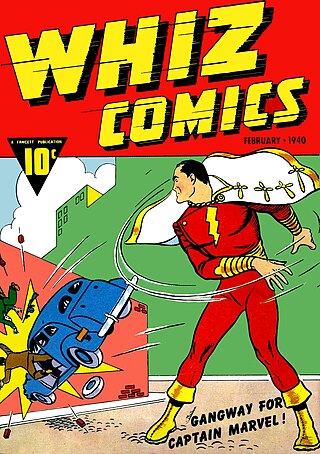
A superhero or superheroine is a stock character who typically possesses superpowers or abilities beyond those of ordinary people, is frequently costumed concealing their identity, and fits the role of the hero; typically using their powers to help the world become a better place, or dedicating themselves to protecting the public and fighting crime. Superhero fiction is the genre of fiction that is centered on such characters, especially, since the 1930s, in American comic books, as well as in Japanese media.

Archie Comic Publications, Inc., is an American comic book publisher headquartered in Pelham, New York. The company's many titles feature the fictional teenagers Archie Andrews, Jughead Jones, Betty Cooper, Veronica Lodge, Reggie Mantle, Sabrina Spellman, Josie and the Pussycats and Katy Keene. The company is also known for its long-running Sonic the Hedgehog comic series, which it published from 1992 until 2016.

Green Lantern is the name of several superheroes appearing in American comic books published by DC Comics. They fight evil with the aid of rings that grant them a variety of extraordinary powers, all of which come from imagination, fearlessness, and the electromagnetic spectrum of emotional willpower. The characters are typically depicted as members of the Green Lantern Corps, an intergalactic law enforcement agency.
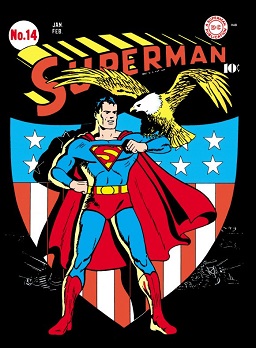
The Golden Age of Comic Books describes an era in the history of American comic books from 1938 to 1956. During this time, modern comic books were first published and rapidly increased in popularity. The superhero archetype was created and many well-known characters were introduced, including Superman, Batman, Robin, Captain Marvel, Captain America, and Wonder Woman.

Neal Adams was an American comic book artist. He was the co-founder of the graphic design studio Continuity Associates, and was a creators-rights advocate who helped secure a pension and recognition for Superman creators Jerry Siegel and Joe Shuster. During his career, Adams co-created the characters John Stewart, Man-Bat, and Ra's al Ghul for DC Comics.
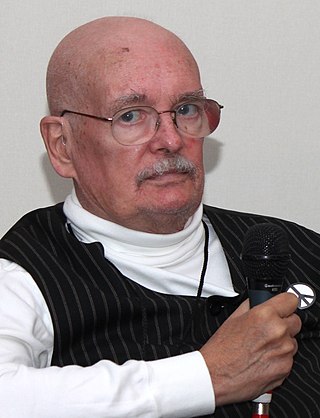
Dennis Joseph O'Neil was an American comic book writer and editor, principally for Marvel Comics and DC Comics from the 1960s through the 1990s, and Group Editor for the Batman family of titles until his retirement.

Dark Circle Comics is an imprint of Archie Comics Publications, Inc. Under its previous name, Red Circle Comics, it published non-humor characters, particularly superheroes in the 1970s and 1980s.
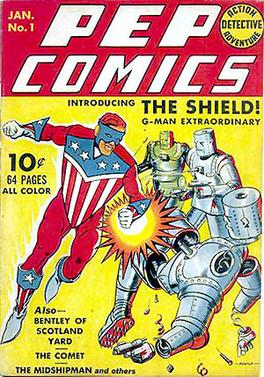
The Shield is the name of several superheroes created by MLJ. Appearing months before Captain America, the Shield has the distinction of being the first superhero with a costume based upon United States patriotic iconography. The character appeared in Pep Comics from issue #1 to #65.
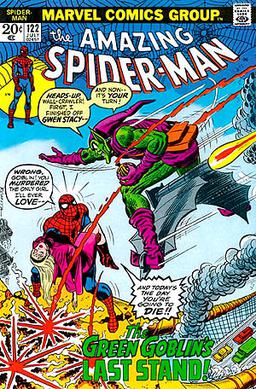
The Bronze Age of Comic Books is an informal name for a period in the history of American superhero comic books, usually said to run from 1970 to 1985. It follows the Silver Age of Comic Books and is followed by the Modern Age of Comic Books.
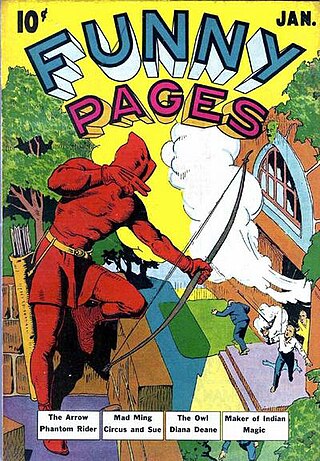
The Arrow is a fictional superhero created during the Golden Age of Comic Books. He was the first superhero published by Centaur Publications.

Ms. Mystic is a comic book superhero created by comic book artist/writers Neal Adams and Michael Netzer. The character's first full appearance was in Captain Victory and the Galactic Rangers #3, published by Pacific Comics. After Pacific published two issues, the character was published by Adams' own company Continuity Comics, for a total of nine issues between 1982 and 1994.

The Skyman is a fictional comic book superhero that appeared stories during the Golden Age of Comic Books. Created by writer Gardner Fox and artist Ogden Whitney, the character first appeared in the Columbia Comics omnibus title Big Shot Comics #1. He is unrelated to the DC Comics character.

Miss Masque is a fictional masked crime-fighter. She originally appeared in comic books published by Nedor Comics, and was later revived by AC Comics, America's Best Comics, and Dynamite Entertainment.

Pyroman is a fictional superhero that appeared in comic books published by Nedor Comics. His first appearance was in Startling Comics #18, with art by Jack Binder. This character was later revived by both AC Comics and America's Best Comics.

The Woman in Red is a fictional character that first appeared in the period known to comic book historians as the Golden Age of Comic Books. Created by writer Richard E. Hughes and artist George Mandel, she first appeared in Thrilling Comics #2, published by Nedor Comics. The character was later revived by writer Alan Moore for America's Best Comics. She would also be used by Dynamite Entertainment in Project Superpowers Chapter Two.

The Face is a fictional character, a comic book superhero that appeared in 1940s comics during what historians and fans call the Golden Age of Comic Books. He was created by artist Mart Bailey and an unknown writer.
Notable events of 1970 in comics.
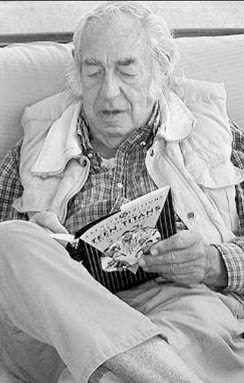
Robert Gilbert Haney, Jr. was an American comic book writer, best known for his work for DC Comics. He co-created the Teen Titans as well as characters such as Lance Bruner, Metamorpho, Eclipso, Cain, and the Super-Sons.

Superhero comics is one of the most common genres of American comic books. The genre rose to prominence in the 1930s and became extremely popular in the 1940s and has remained the dominant form of comic book in North America since the 1960s. Superhero comics feature stories about superheroes and the universes these characters inhabit.
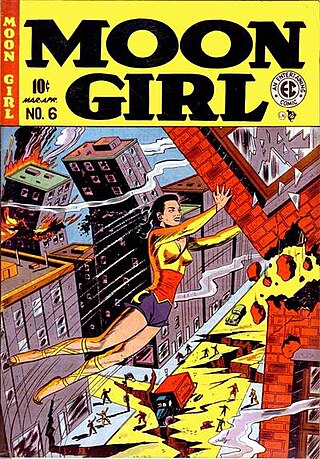
Moon Girl is a fictional character published by EC Comics from 1947 to 1949. Moon Girl is a character from the Golden Age of Comic Books and has since passed into the public domain. Her secret identity is Claire Lune, a junior high history teacher.
References
- ↑ Morris, Jon (2015). The League of Regrettable Superheroes: Half Baked Heroes from Comic Book History. Philadelphia, Pennsylvania: Quirk Books. pp. 236–237. ISBN 978-1-59474-763-2.
- ↑ Skateman at the Grand Comics Database.
- ↑ Skateman at Don Markstein's Toonopedia; published 2009, retrieved June 2, 2014. Archived from the original on May 6, 2015.
- ↑ the Slings & Arrows Comics Guide; edited by Frank Plowright; published by Top Shelf Productions, 2003 (via Google Books)
- ↑ World's Worst Comics Awards (1990) - no. 2, at comicbookdb.com; retrieved June 2, 2014
- ↑ Fallout: J. Robert Oppenheimer, Leo Szilard, and the Political Science of the Atomic Bomb, (page 237) by Jim Ottaviani (via Google Books); published 2001 by GT Labs
- ↑ 6 Superheroes That Should Never Have Become Superheroes, by Francesco Marciuliano, at Smosh.com; published April 16, 2013; retrieved June 2, 2014
- ↑ K. Thor Jensen (April 13, 2010). "The 20 Worst Superheroes". heavy.com . Archived from the original on 15 July 2017. Retrieved June 2, 2014.
- ↑ BLOG Comics’ Most Ludicrous Weapons, by Matt Risley, at SFX ; published April 25, 2011; retrieved June 2, 2014
- ↑ 5 Superhero Movies That Should Never Get Made, by Ryan Kristobak, at the Huffington Post; published November 15, 2013; retrieved June 2, 2014
- ↑ Deconstructing the Complete and Utter Insanity of ‘Batman: Odyssey’ Archived 2014-06-06 at the Wayback Machine , by Laura Hudson; at ComicsAlliance; published March 8, 2011; retrieved June 2, 2014
- ↑ The History Of Comic Books In San Diego: The '80s, by Jay Allen Sanford; at the San Diego Reader ; published September 14, 2008; retrieved June 2, 2014